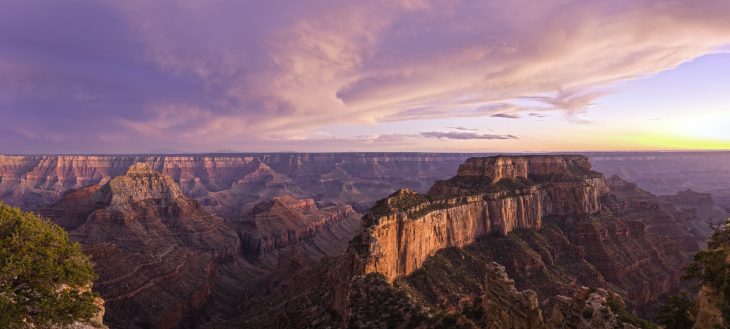
The Grand Canyon is arguably the world’s most famous canyon. Located in the United States, the Grand Canyon is one of the planet’s greatest on-going geological spectacles. Its desolate beauty is also one of a kind. Find out more about it with these Grand Canyon National Park facts!
- The Grand Canyon is in Arizona, United States.
- The area is carved by the Colorado River.
- The Canyon is also close to the borders of Nevada and Utah.
- The Grand Canyon is 446 km long and 29 km wide.
- The Canyon’s depth is nearly a mile or 1,857 m.
- The Native Americans inhabited the Grand Canyon for thousands of years.
- The Native Americans also build their settlements around 200 B.C.
- García López de Cárdenas was the first European to visit the Grand Canyon in the year 1540.
- The Grand Canyon is a river valley in the Colorado Plateau.
- The Canyon exhibits the uplifted Paleozoic strata, the earliest of three geologic eras, and the Proterozoic era.
- The coldest ever temperature recorded in the Grand Canyon is –30°C on the North Rim on February 1, 1985.
- The hottest temperature in the Canyon was 48°C which was recorded at Phantom Ranch.
- The Grand Canyon is famous for its massive land area, as well as its complex and vibrant landscape.
- The Grand Canyon’s official land area is 4,926 km² or roughly over 4 times the size of Hong Kong.
- The Canyon has a collection of a thick sequence of ancient rocks. These old rocks are well preserved and exhibited in the canyon’s walls.
- Former US President Theodore Roosevelt was a significant advocate of the Grand Canyon’s preservation.
- President Roosevelt is also known to visit the Canyon several times to hunt and to relish the scene.
- The Grand Canyon is one of the world’s largest canyons.
- The Canyon is part of the 28 finalists of the New7Wonders of the world.
- The Grand Canyon is one of the seven natural wonders of the world.
Grand Canyon National Park Facts Infographics
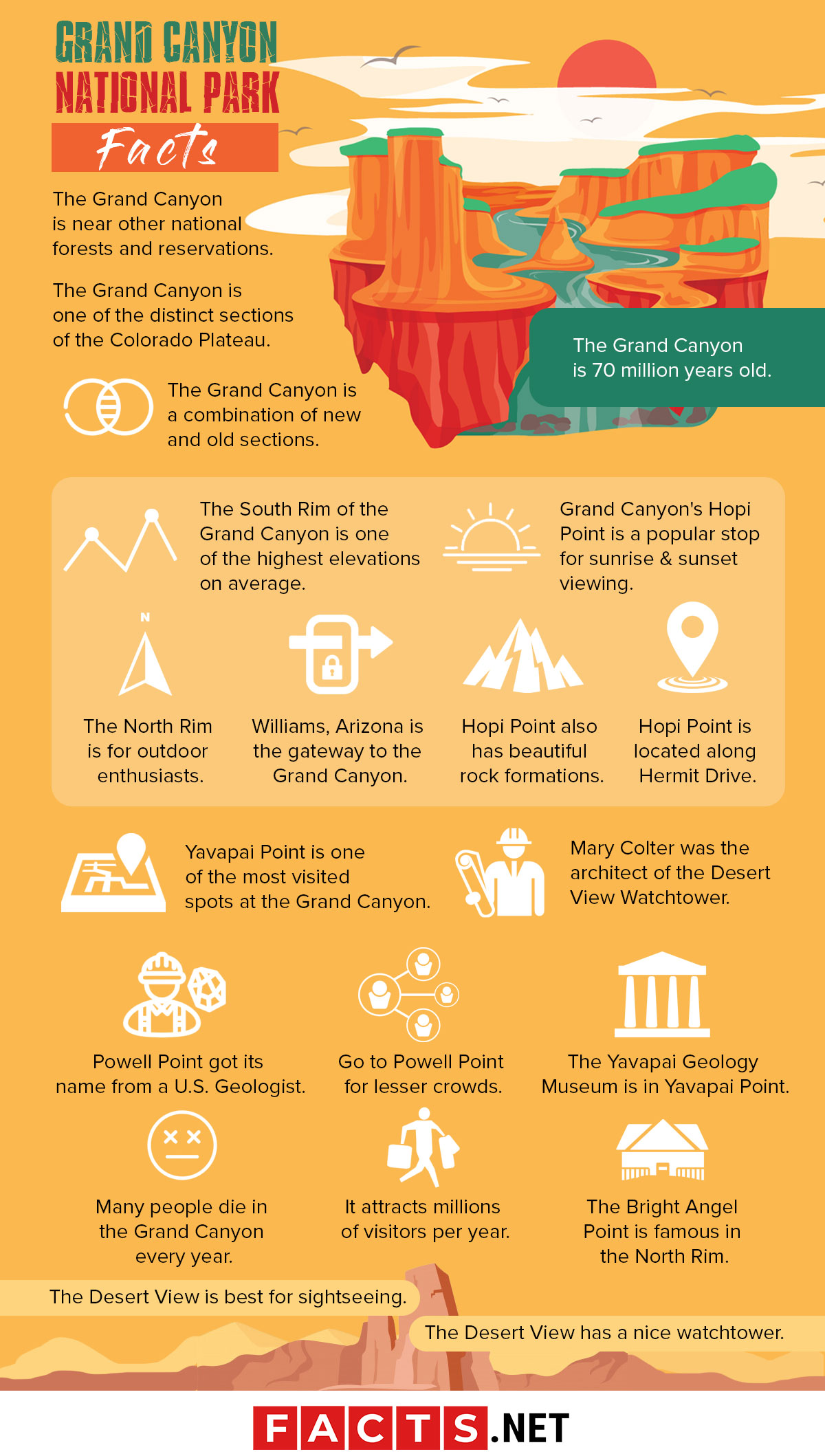
The Grand Canyon is near other national forests and reservations.
The canyon and adjacent rim are inside the Grand Canyon National Park, the Havasupai Indian Reservation, Grand Canyon-Parashant National Monument, the Kaibab National Forest, the Navajo Nation, and the Hualapai Indian Reservation.
The Grand Canyon is one of the distinct sections of the Colorado Plateau.
Along with the Uinta Basin, Datil sections, Navajo, High Plateaus, and Canyonlands, the Grand Canyon is one of the six distinct sections of the Colorado Plateau. The Colorado Plateau is a physiographic and desert region of Intermontane Plateaus of the US.
The Grand Canyon is a combination of new and old sections.
According to several researchers, the Grand Canyon is a combination of “new” and old sections. The researchers published the study in Nature Geoscience, a monthly peer-reviewed scientific journal.
The Grand Canyon is 70 million years old.
Many scientists believe that the Grand Canyon is approximately 70 million years old and the layered rocks in the canyon revealed the early geologic history of the North American continent.
The South Rim of the Grand Canyon is one of the highest elevations on average.
The average elevation of the Colorado River at the bottom of the Canyon is about 2,200 ft or 670 m. Meanwhile, the usual elevation in the South Rim is approximately 6,800 ft or 2,072 m.
Williams, Arizona is the gateway to the Grand Canyon.
The South Rim is located 96 km north of Williams, Arizona and 128 km northwest of Flagstaff, Arizona. If you want to go to the Grand Canyon, go to Williams first!
The North Rim is for outdoor enthusiasts.
The North Rim is a populated area in Coconino County, Arizona, and adjacent to within Grand Canyon National Park. It has a Visitor Center, Grand Canyon Lodge, and multiple hiking trails, such as the Transept Trail and Bright Angel Point Trail.
Grand Canyon's Hopi Point is a popular stop for sunrise & sunset viewing.
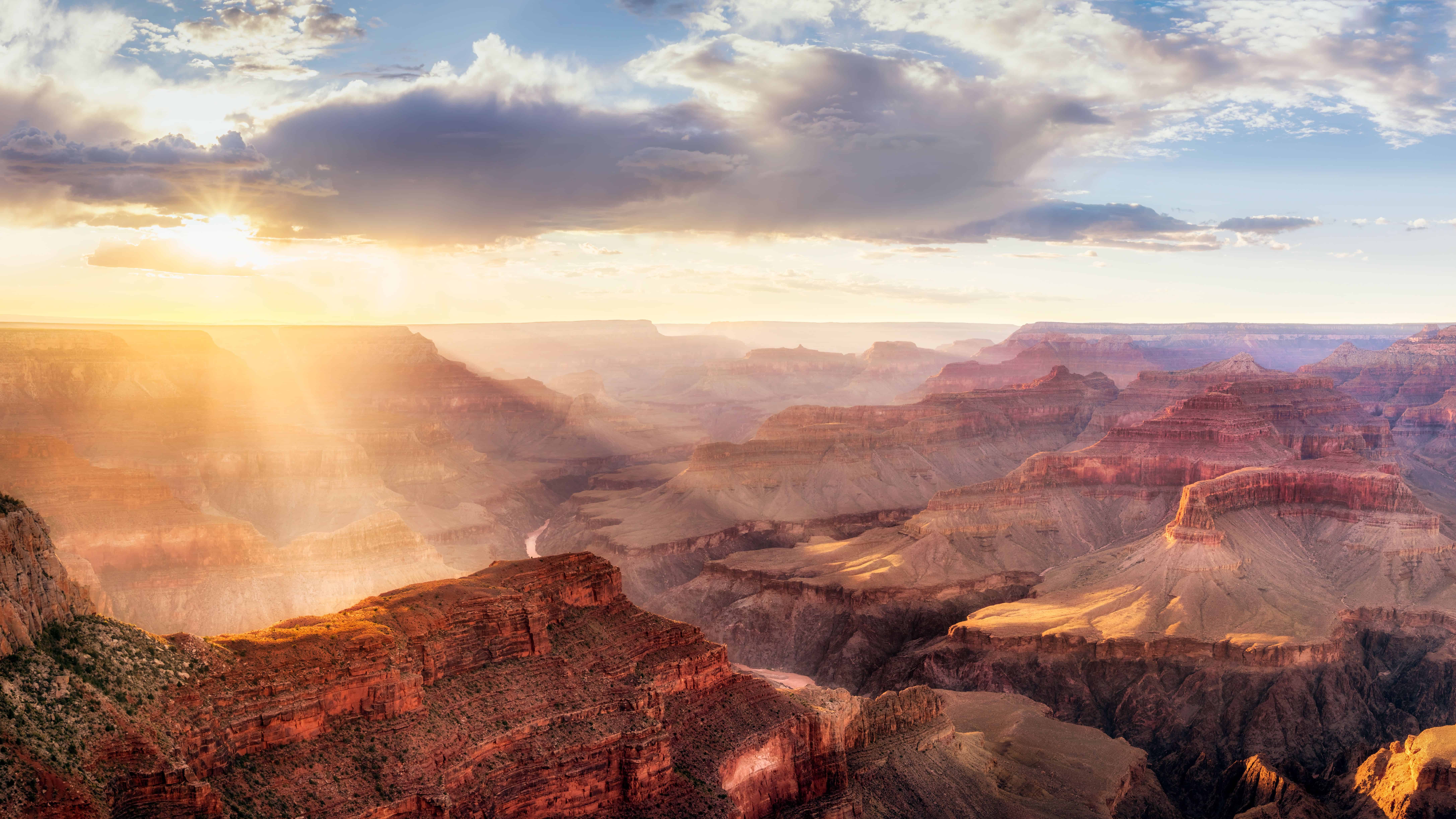
When it comes to all-around viewpoints in the Canyon, the Hopi Point is one of the best. Its view reaches out greater than any other point on the South Rim. Furthermore, it provides tremendous sceneries to the east and west with an exceptional view for both sunrise and sunset.
Hopi Point is located along Hermit Drive.
Hopi Point is located along Hermit Drive, a scenic route along the west end of Grand Canyon Village. Hermit Drive prohibits private vehicles from March to November although it provides a free shuttle service near Bright Angel Lodge.
Hopi Point also has beautiful rock formations.
Apart from being a popular stop for sunrise & sunset viewing, Hopi Point offers wonderful views of rock formations or also known as “stone temples” beneath the Canyon.
Go to Powell Point for lesser crowds.
The Powell Point lies at the east of Hopi Point. Although it’s not as “famous” as Hopi Point’s sunrise & sunset viewing, Powell Point’s sunrise scenery is arguably as good but with lesser visitors.
Powell Point got its name from a U.S. Geologist.
Powell Point is named after John Wesley Powell. He was a geologist, U.S. Soldier, and explorer. Moreover, John Wesley Powell was best known for his exploration of the Colorado River as well as the Grand Canyon.
The Yavapai Geology Museum is in Yavapai Point.
Grand Canyon’s Yavapai Point has the greatest sceneries between the visitor center and Grand Canyon Village. You can also find the Yavapai Geology Museum at the Yavapai Point and discover Grand Canyon’s remarkable geology.
Yavapai Point is one of the most visited spots at the Grand Canyon.
One of the “disadvantages” about the Yavapai Point is that many tourists flocks this place. Hence, you may find its best viewpoint at the visitor center and some hotels nearby frequently jam-packed with people.
The Desert View is best for sightseeing.
The Desert View is the easternmost viewpoint on the South Rim. It is one of the highest elevations in the Grand Canyon with more than 7,400 ft on average, thus offering some of the best signature views of the Canyon.
The Desert View has a nice watchtower.

Hikers and tourists may also go to the top floor of Desert View Watchtower. The watchtower is a 70-foot tall stone building that has a 360-degree view. During a very bright sunny day, spectators can see the view of over 160 kilometers of the Grand Canyon.
Mary Colter was the architect of the Desert View Watchtower.
American architect and designer Mary Colter took more than five months researching archeological prototypes and construction techniques. After that, she constructed a model of the site and worked on the design of the tower using clay.
The Bright Angel Point is famous in the North Rim.
The Bright Angel Point is arguably the most famous viewpoint on the North Rim. Its elevation is around 8,148 ft or about 1,000 ft higher compared to the South Rim.
Many people die in the Grand Canyon every year.
On average, around 10 to 12 people die each year in the Grand Canyon. The main causes of death in the Canyon are mixed. But mostly, it comes from the scorching heat, dehydration, drowning, natural causes, medical problems, traffic crashes, falling from the rims, and even suicide.
It attracts millions of visitors per year.
The Grand Canyon is one of the most visited national parks in the United States with over 5.5 million local and international tourists who visit this landmark every year.
There are many activities tourists can do at the Grand Canyon.
Tourists go to the Grand Canyon for many reasons as activities such as hiking, horseback riding, burro riding, swimming, rafting, sightseeing, and just even a simple walk along with some fresh air, and so much more.
It's not "ideal" to visit the Grand Canyon during the summer.
The perfect or ideal time to go in the Grand Canyon is March through May and September through November. During these months, daytime temperatures are cool. You can expect fewer visitors during these months. However, if you’re visiting the Grand Canyon during the peak season (in summer), get ready for a large number of tourists as well as a limited hotel availability.
It is the second most popular national park in the U.S.
The Grand Canyon is the second most popular national park in the United States after the Great Smoky Mountains (with more than 11 million visitors per year) of North Carolina and Tennessee.
There are a lot of different animal species living in the Grand Canyon.
The Grand Canyon has over 70 species of mammals, an estimated count of 50 species of reptiles and amphibians, 25 species of fish, and over 300 species of birds.
There are mountain lions in the Grand Canyon.

One of the most unusual mammals in the Grand Canyon is the mountain lion or also known as puma or cougar. Mountain lions are solitary animals and they tend to avoid humans. It is rare to see them in the canyon region, but records of these creatures exist in the area.
There are 6 species of rattlesnake in the Grand Canyon.
The Grand Canyon’s rattlesnake is one of the most common snake species in the field. In fact, there are 6 rattlesnake species (Speckled Rattlesnake, Mojave Rattlesnake, Great Basin Rattlesnake, Hopi Rattlesnake, Grand Canyon Pink Rattlesnake, and the Black-Tailed Rattlesnake) in the Grand Canyon. They are the most poisonous animals in the park, so be careful!
Grand Canyon's Arizona bark scorpion is the most poisonous scorpion in North America.
Rattlesnakes are not alone in the title of the most poisonous creatures in the Grand Canyon. There are at least three species of scorpions inhabiting the land. The Grand Canyon’s Arizona bark scorpion is the most dangerous, not just in the Grand Canyon, but the most poisonous scorpion in North America. Its sting can cause numbness, tingling, vomiting, and even death.
There are California condors in the Grand Canyon.
The Grand Canyon is home to a huge population of the birds-of-prey and one of them is the California condor, a rare bird species. It is listed by International Union for Conservation of Nature as an endangered species. This bird was once listed as extinct in the year 1987, but now, it’s reintroduced into northern Arizona and southern Utah.
There are a lot of coyotes in the Grand Canyon.
It is common to see a coyote in the Grand Canyon. Coyotes live inside the Canyon as well as at the top of the rims, and even near the garbage area of the campsites to scavenge for food.
Mule deer usually live in the South Rim of the Grand Canyon.
The mule deer are also amongst the most common animals in the Grand Canyon. These animals mostly live in the South Rim of the Grand Canyon National Park. Motorists around the area are asked to drive slowly to avoid confrontation with the mule deer which often moves in front of cars.
The Grand Canyon has over 20 bat species.
The Grand Canyon is also home to over 20 species of bats. The Canyon’s structure gives them protection and shelter, especially to threatened bat species.
The ring-tailed cat is the state mammal of Arizona.
The Bassariscus Astutus or much known as the ring-tailed cat is a mammal from the raccoon family. These raccoons are found in areas that usually lack water including the Grand Canyon.
One of the biggest lizard species lives in the Grand Canyon.
Lizards such as the eastern collared lizard occupies the Grand Canyon region. The collared lizard is one of the biggest species of lizard in the United States. The lizard’s length ranges from 8 up to 14 inches and have big heads and powerful jaws.
Most visitors see the Grand Canyon from the South Rim.
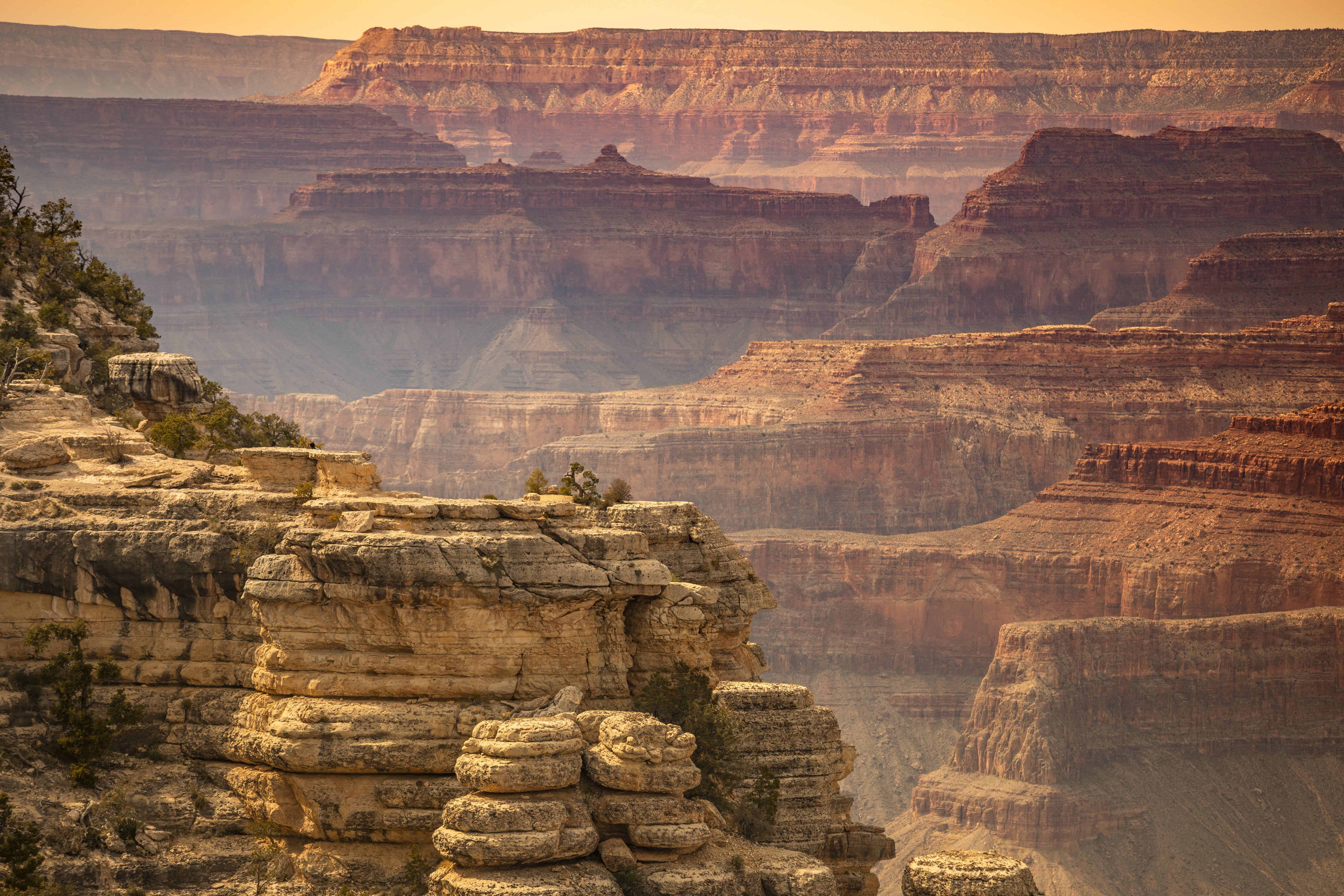
More than 80% of the tourists and visitors of the Grand Canyon visit the South Rim since its open all year long. The South Rim also provides free park shuttle bus rides.
The vehicle permit costs around $35.
The Grand Canyon National Park vehicle permit costs around $35. It allows one private, non-commercial vehicle and all its passengers, up to 15 persons.
The motorcycle permit costs about $30.
The Grand Canyon National Park motorcycle permit costs about $30. It only allows a single, private, non-commercial motorcycle and up to 1 passenger.
The Individual Permit costs $20 per person.
The Grand Canyon National Park Individual Permit costs $20 per person. The permit allows an individual to enter by foot, park shuttle bus, Grand Canyon Railway, private rafting trip, or by using a bicycle. Any person who is younger than 15 years old is free of charge.
Permits are valid for 1 week.
All of the permits (Private Vehicle, Motorcycle, Individual) are valid for up to seven days.
The annual pass is less than $100.
The Grand Canyon National Park Annual Pass would cost about 70 dollars. It is valid for 12 months from the date of acquisition for unlimited visits to the Grand Canyon.
It's not recommended to do outdoor activities between 10 am to 4 pm.
Part of Grand Canyon’s recommendations is to avoid outdoor activities during the heat of the day which is around 10 am to 4 pm as temperatures may rise to 46°C inside Grand Canyon and 32°C at the Canyon Rims.
Make sure you're well packed if you plan to roam the Canyon throughout the day.
If you’re an outdoor enthusiast and want to enjoy the Grand Canyon throughout the day, it is suggested to bring a lot of water, electrolyte drinks, salty snacks, a bottle spray to keep yourself wet and cool. Also bring balanced food to keep your energy up!
Multiple search and rescue operations are very common.
The United States government is well aware of the possible risks and dangers for the visitors who go inside the Grand Canyon. Because of this, its also common for the authorities to have multiple search and rescue operations throughout the year. However, due to the massive land area of the Canyon, your due diligence is still your primary ally.
About 800 people already died in the Grand Canyon.
More than 800 people already died inside the Grand Canyon based on its unofficial tally, without counting its suicide cases. In theory, those numbers are still “acceptable” for it draws millions and millions of visitors each year. Despite this, it’s generally safe to visit provided that you are following its recommendations and guidelines.
You can create your itinerary in the Grand Canyon.
One of the most common questions as a tourist in the Grand Canyon is, “Can I go to the Grand Canyon without a tour?” Going to the Grand Canyon does not require a tour or itinerary. Moreover, the Grand Canyon National Park South Rim is much known to be a “Do It Yourself” place for its tourists and visitors.
Pets are allowed in the Grand Canyon.
Another common question is, “Can I bring my dog along with me if I hike into the Canyon?” According to the rules, dogs and cats are allowed provided that they are leashed and physically restrained. However, if the pet is a certified service dog, then it could be exempted.
There are no dams inside the Grand Canyon.
Although there are no dams inside the Grand Canyon, there are several dams within its border that provide a positive effect in Grand Canyon’s environment. Some of those dams also release water that supports the water flow through Grand Canyon.
It became a National Park in 1919.

In 1893, Grand Canyon had the Federal protection as a Forest Reserve and afterward as a National Monument. It finally achieved the National Park status in 1919, three years after creating the National Park Service.
The South Rim is very accessible.
The most common driving route going to the South Rim is the Flagstaff (via US Highway 180) and Williams, Arizona (via State Route 64 from Interstate 40). Several commercial airlines are also available at the Grand Canyon Airport. Lastly, there is a convenient public bus transport if tourists are not into driving.
The Grand Canyon Airport is in Tusayan, Arizona.
The Grand Canyon National Park Airport lies in Tusayan, a town in Arizona, It is a state-owned public-use airport and it’s near Grand Canyon National Park. It’s just 11 km away from the South Rim of the Grand Canyon.
The Grand Canyon Airport is one of the busiest airports in Arizona.
The Grand Canyon Airport first opened in October 1965. As of today, it is the fourth most active air carrier airport in the state along with Tucson International Airport, Phoenix-Mesa Gateway Airport, and Phoenix Sky Harbor International Airport.
There is limited public transportation going to the North Rim.
In contrast to the convenience of going to the South Rim, the North Rim does not have as many choices. If you’re going to the North Rim, the best option is to drive State Route 389 to Jacob Lake (south of the Utah border) and take Highway 67 to the North Rim or US Highway 89A. Take note that the road is closed from late October to mid-May due to heavy snow.
The weather in the Grand Canyon can be unpredictable.
If you plan to visit the Grand Canyon National Park, you should be prepared physically and mentally for this.
You can find a lodge inside the National Park.
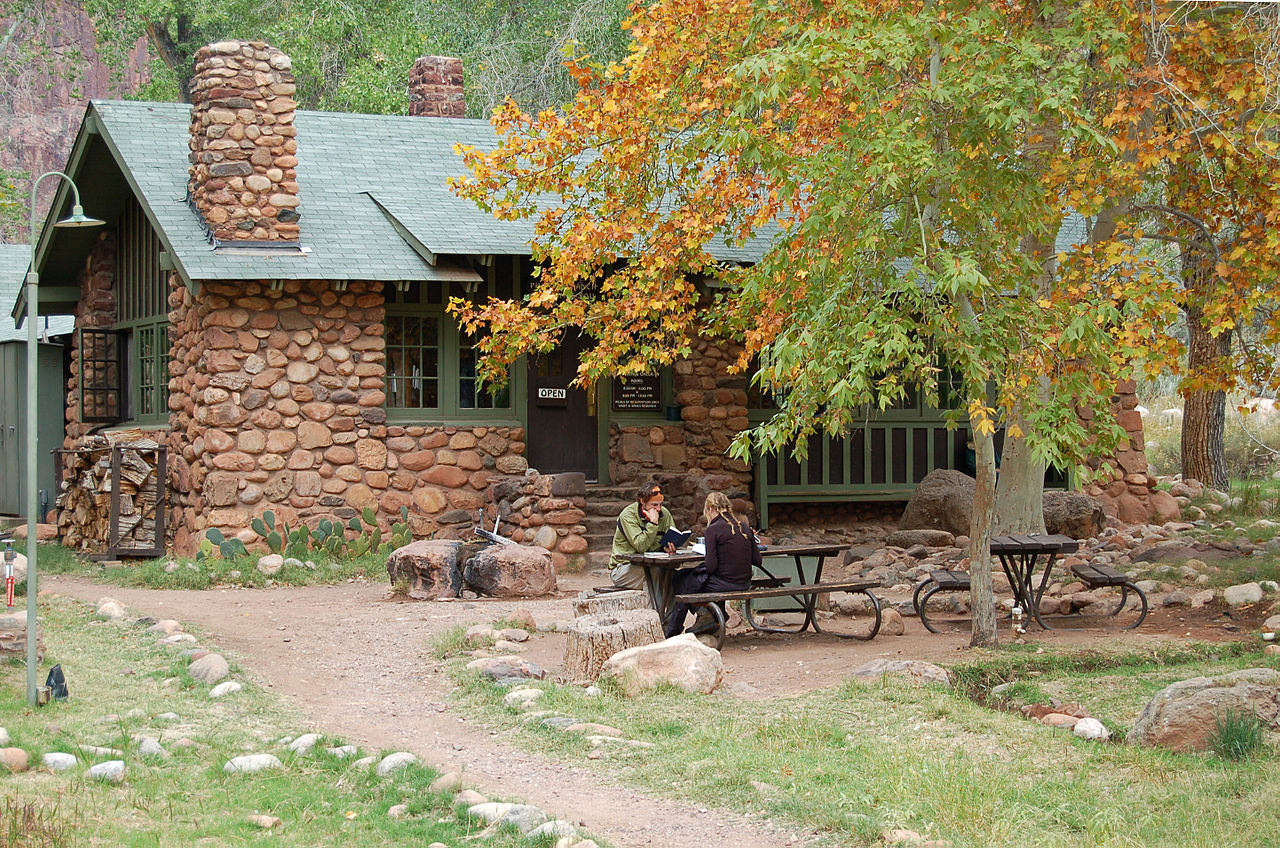
The Phantom Ranch is a lodge inside the National Park. It’s located at the bottom of Grand Canyon, on the eastern side of Bright Angel Creek. It’s a famous destination for both mule riders and hikers where they can reserve cabins along with some delicious meals.
Reservation at the Phantom Ranch should be made 15 months in advance.
Yes, at least one year in advance. The reservation is made via online lottery. One of the advantages of this reservation is that its overnight guests don’t need to obtain backcountry camping permits anymore.
You can use a raft to go to the Phantom Ranch.
Aside from mule riding and hiking, you can also visit the historical oasis of the Phantom Ranch by rafting the Colorado River, making your journey at the Grand Canyon more adventurous.
Native Americans lived in the Phantom Ranch a long time ago.
Native Americans lived in the Phantom Ranch and its surrounding environment before the land, and subsequently the whole United States, was colonized. They left many artifacts such as split-twig figurines carbon-dated at 4000 years old have been identified in nearby caves.
The Pueblo people grew some crops at the Grand Canyon.
Around 1050 AD, the Pueblo people have inhibited Grand Canyon and built houses. They also have a ceremonial kiva, rooms of the Pueblo people for rites and political meetings, in the place. These people likely survived by growing crops such as beans, corn, squash, and hunting wild animals.
Mule riding is more than a century year-old tradition.
Mule riding in the Grand Canyon is a longtime tradition. It’s perfect for individuals who don’t have the stamina or capacity to hike the Canyon. The ride will take you to the park’s woodlands and scenic canyon overlooks, and its available both the North and South Rims.
Hiking the Grand Canyon is not your typical mountain trek.
In contrast to a regular mountain trekking or hiking, the Grand Canyon trails have a downhill trip followed by an exhausting uphill climb. Hiking in the Grand Canyon can be extremely difficult even for the seasoned veterans, although some children, seniors, and even handicaps have made it through and proved that it’s possible.
The Grand Canyon Village has an institute that offers classes and tours.
The Grand Canyon Association Field Institute is a training center in Grand Canyon Village, Arizona. They offer educational classes and tours. Tourists can learn about Grand Canyon’s geology, cultural & natural history classes straight from the experts – geologists, ecologists, archaeologists, and historians.
The Grand Canyon Association Field Institute is your best choice if you don't know what to do.
The Grand Canyon Association Field Institute provides day hikes & tours, service-based trips, guided backpacking & hiking trips, cultural & history classes, training & certification courses, and even writing, art, photography, and yoga classes.
The average hiking speed in the Canyon is 1.6 kmph.
Most of the first time hikers in the Grand Canyon that walk uphill have an average speed of 1.6 kmph. Depending on the person’s age and fitness, knowing that average speed is important so you can track your journey well and safely from one location to another.
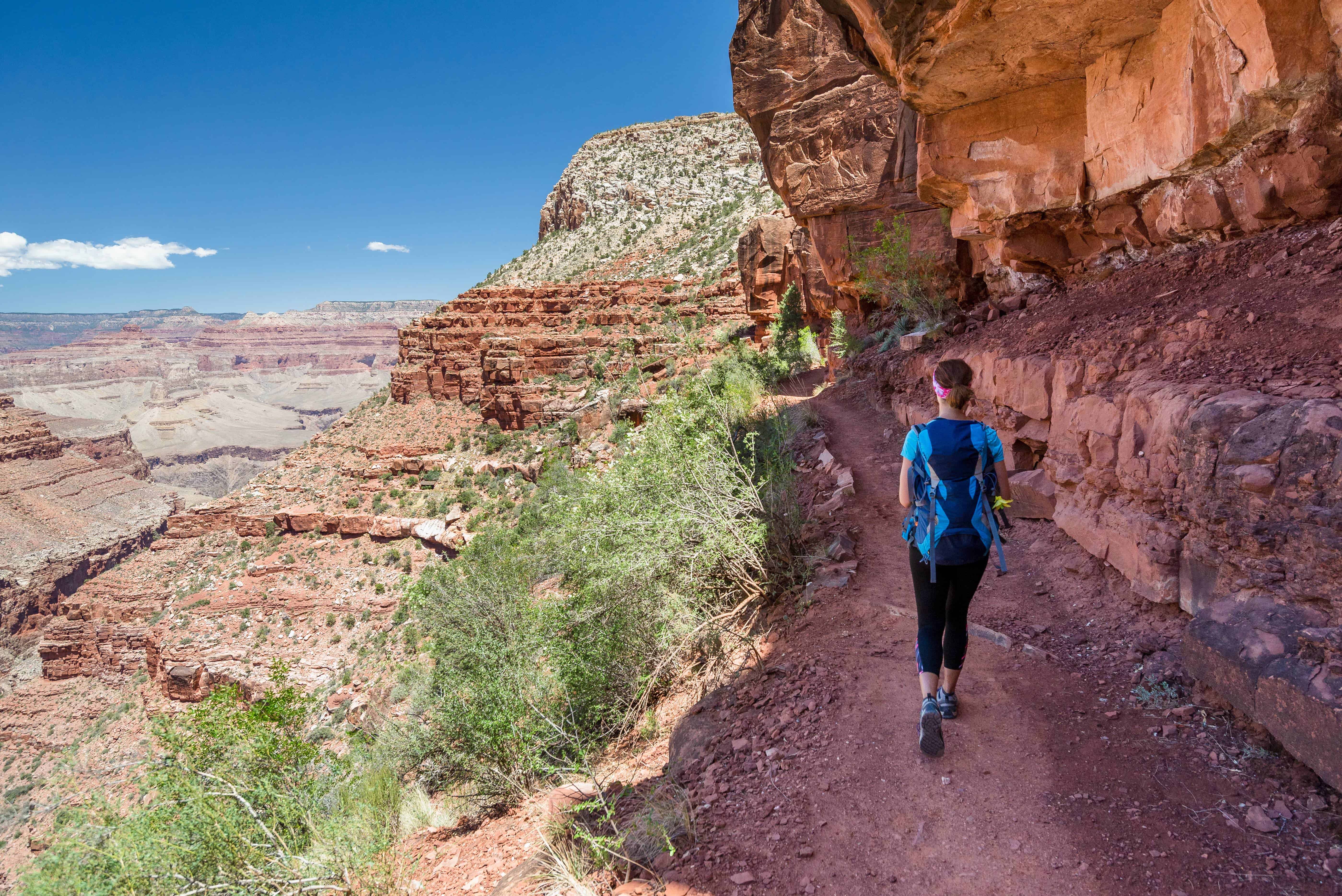
It is not advisable to go for an adventure alone.
Although some people managed to go hiking or rafting in the Grand Canyon alone, it is not advisable. According to the National Park’s recommendation, risks are very high when you go alone as no one will be able to help you if you get injured, ill, or lost.
David Whittlesey is a Grand Canyon survivor.
The TV series “I Shouldn’t Be Alive,” has documented the story of David Whittlesey. He managed to survive in the fierce environment of the Grand Canyon alone. David went rafting by himself through the Colorado River when an unfortunate thing happened. Watch it here.
Hikers should drink 4L of water per day.
During the warm months, all hikers must carry and drink approximately 4L of water per day. It’s also recommended to monitor your “ins and outs” as well as the clarity, frequency, and volume of your urine.
Clean drinking water is only accessible in a few areas.
Clean drinking water is only accessible in a few areas at the Canyon along the Corridor trails, so you should carry extra water with you. Water may also be collected straight from the Colorado River, potholes, and creeks. However, it is advisable to treat it first with iodine tablets, or by boiling, or using filters before drinking.
The South Rim is filled with family-oriented activities.
For non-extreme outdoor enthusiasts or just a simple family get together, the Grand Canyon South Rim is the best place to visit in the National Park. The South Rim is open year-round and filled with family-oriented activities, and complete hospitality services.
Kids are eligible to become a Junior Ranger.
Kids of ages four and above can obtain an official Grand Canyon Junior Ranger badge. To do so, they need to fulfill the conditions listed in the activity book and perform a pledge in front of a park ranger.
Both the North and South Rim are an excellent spot for stargazing.
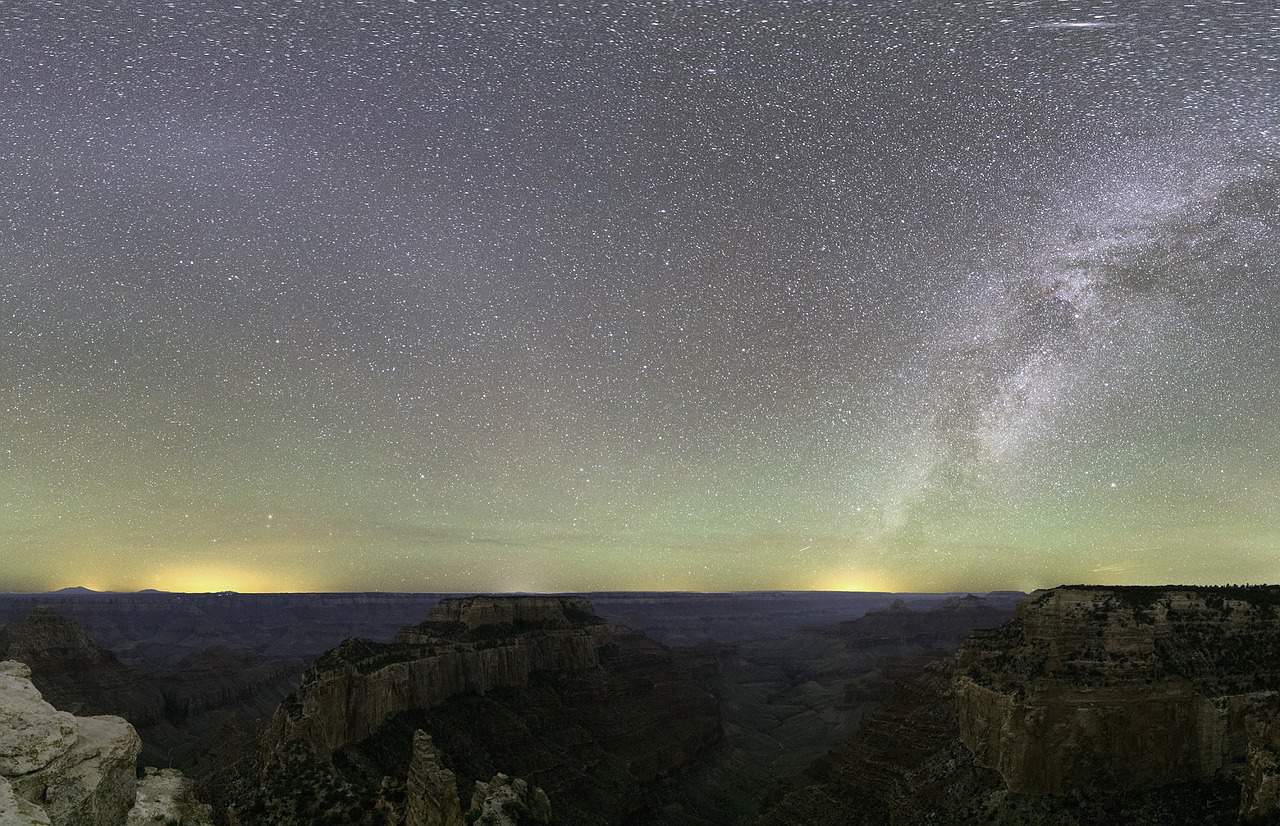
The clear dark sky evening in the Grand Canyon is perfect for watching the stars and planets up above. For unobstructed views, star lovers can travel to either the North Rim or South Rim areas of the park to witness the space’s vastness.
There is a star party in the Grand Canyon.
Every summer the Grand Canyon organizes a star party, providing telescopes, and free astronomy activities. Regularly, the start party starts happens every June on both the South and North Rims around 8 PM.
The Grand Canyon Skywalk is in Eagle Point, sitting at the edge of a side canyon.
The Grand Canyon Sidewalk is a “horseshoe-shaped” structure and cantilever bridge with a glass walkway. Its elevation from the Colorado River is about 1,160 feet or 350 meters. The Grand Canyon Skywalk attracts over 1 million tourists each year.
The Grand Canyon is not the deepest canyon on earth.
Tibet’s Yarlung Tsangpo Grand Canyon is the world’s deepest canyon. It is more than 2 mi deeper than the Grand Canyon and also around 30 mi longer than the Grand Canyon.
There are no dinosaur bones in the Grand Canyon.
Although the Grand Canyon may seem to be a perfect place to find dinosaur fossils, there are no dinosaur bones in the Canyon. Studies suggest that the Grand Canyon didn’t form until after the dinosaurs became extinct.
There are several rare ancient marine fossils in the Grand Canyon.
The Grand Canyon may not have dinosaur fossils but it has preserved some of the rarest ancient marine fossils. These fossils date back for more than 1 billion years ago to relatively new land mammals that left their remains in canyon caves approximately 10,000 years ago.
There are only a few species of fish in the Grand Canyon.
Fishes are not that common in the Grand Canyon. Its extreme climate shift makes it hard for other fish species to adapt in its waters. Only about eight fish species are native to the area, although a few of those are only found in the Colorado River.
Trout is often the most popular fish to catch in the Grand Canyon.
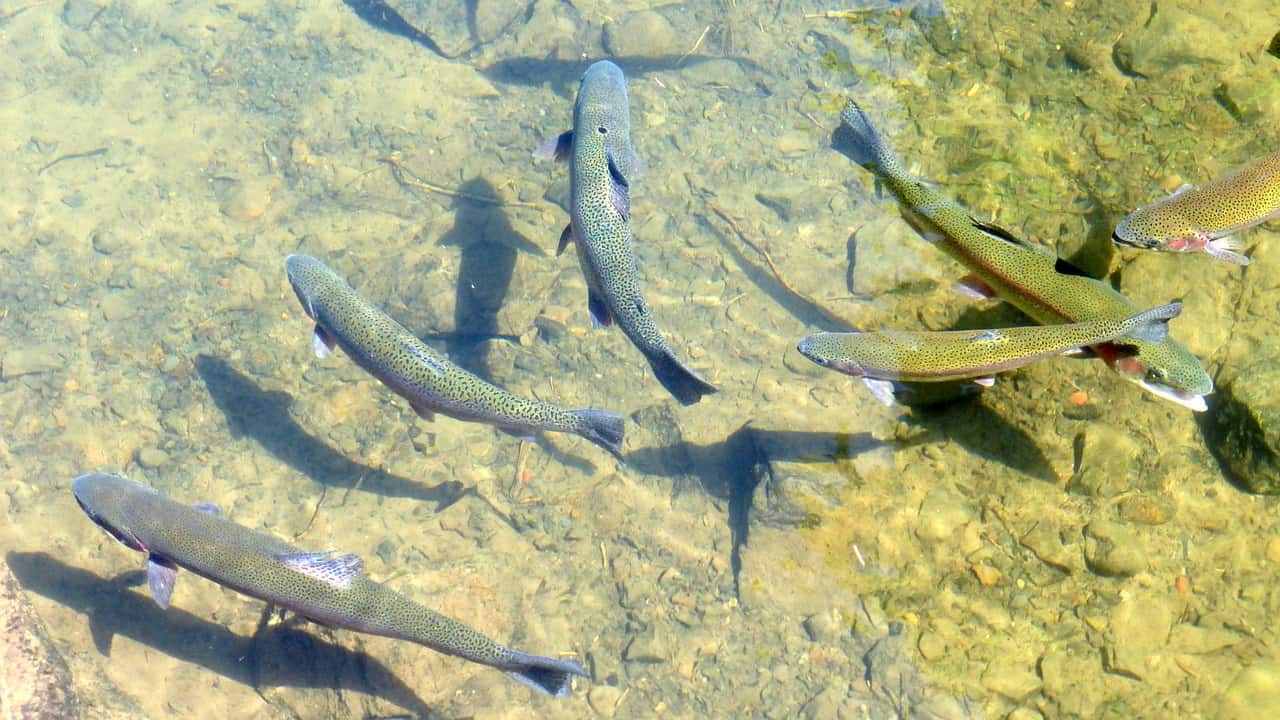
There are other kinds of fish you can catch there. Some of the other species of fish in the Grand Canyon are the razorback sucker, humpback chub, speckled dace, flannelmouth sucker, bluehead sucker, Colorado pikeminnow, bonytail, and roundtail.
There is a town inside the Grand Canyon.
The Supai Village is located in the base of the Grand Canyon within the Havasupai Indian Reservation. It is home to over 200 people. Supai Village is one of the most remote communities in the United States.
The Grand Canyon has around 1,000 hidden caves.
The Grand Canyon has around 1,000 hidden caves and only 300+ of those have been recorded. Hence, only a few of them have been mapped.
The Kolb brothers established a big photography business in the Canyon.
The historic Kolb Studio in the Grand Canyon is on the edge of the South Rim of the Grand Canyon Village. The Kolb brothers, Emery and Ellsworth, operated the business in the early 1900s until 1967 as the photography studio, where they took pictures of the Canyon.
The Kolb brothers also lived in the Grand Canyon.
The Kolb brothers have constructed a building in Grand Canyon for their business. The building is both for the studio as well as their family home. This double purpose structure has been existing in Grand Canyon for more than a century.
The National Park preserved the Kolb brothers' historic photography studio.
The National Park Service has taken over the historic photographic studio when Emery Kolb passed away in 1976. The Grand Canyon Association refurbished the building in the ’90s and it transformed into a bookstore, an art gallery, and an information center. The store highlights a tribute to Kolb’s photographs of the mule riders at Grand Canyon.
Be careful with rock squirrels if you're going to visit the Grand Canyon.
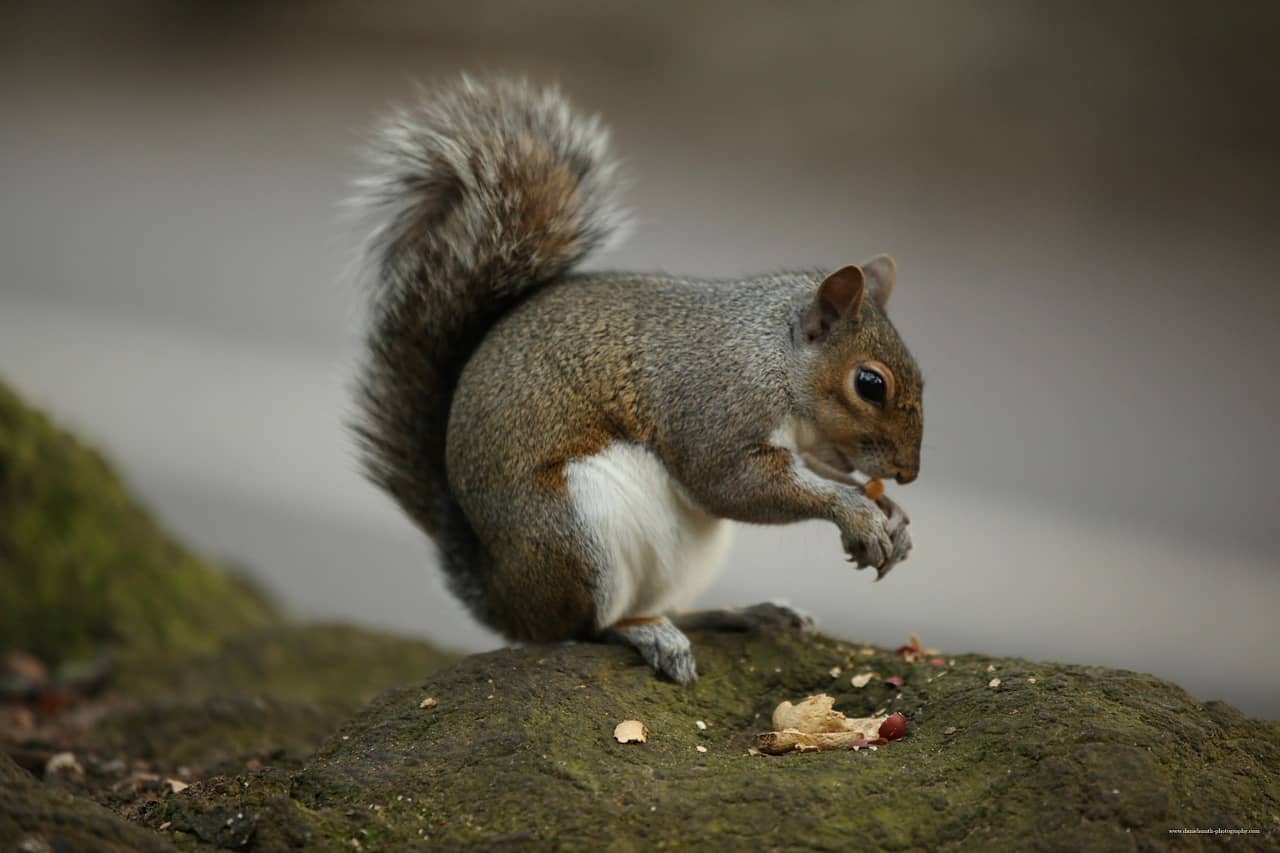
Due to a large number of tourists that feed the rock squirrels either by hand or just simply leaving some food along the trail, these squirrels started to get over familiar with humans and bite them. So be careful!
Some of the rocks in the Grand Canyon has a huge age discrepancy.
The Grand Canyon also represents Great Unconformity. One of geology’s deepest mysteries is the fact that the 250-million-year-old rock layers lie directly against a billion-year-old rock. As of the moment, no one can tell what happened to the hundreds of millions of years of missing layers.
The Grand Canyon's air is one of the cleanest in the U.S.
Although organic compounds such as soot, and dust reduce can reduce the visibility in the Grand Canyon at times, the air in the Grand Canyon is one of the cleanest and freshest air in the United States.
Each year, 40,000 people hike in the back country.
Each year, according to Grand Canyon National Park’s statistics, approximately 40,000 people camp and hike in the back country, mostly below the rim.
Thousands of boat rafters row the Colorado River each year.
The Grand Canyon National Park’s statistics also estimate that more than 25,000 river runners or boat rafters go to the Colorado River every year. There, they can plan a trip of over 10 days.
Rafting in the Colorado River can give you a different outlook on life.
According to individuals that went rafting in the Colorado River, the desolate beauty of the Grand Canyon is described. People say, “there’s no place like the Grand Canyon,” and “almost everybody that goes down there comes back with a different outlook on life.”
Rafting Colorado River can cost you thousands.
The cost to raft Grand Canyon’s Colorado River will depend on how short or long is the trip. For instance, a four-day to the five-day trip will cost you about $1,500 up to $2,000 per person. For a longer getaway (around 15 days), it can cost at least $4,000.
The Federal Aviation Administration is "born" because of the Grand Canyon.
The Federal Aviation Administration (FAA) is created because of the Grand Canyon. During the 1950s, passenger airplanes usually took detours over the Grand Canyon for the passengers to see its majestic view. However, in 1956, two of these planes have crashed and there were no survivors. Two years after the incident, the FAA was established to monitor and handle air traffic.
Researchers discovered hundreds of prehistoric split-twig figurines in the Canyon.
Many split-twig figurines have been found in the canyon walls and formed into a bighorn sheep and deer. Researchers agree that the ancient hunters used these materials as a religious icon.
Tourism in the Grand Canyon picked up gradually.
The Grand Canyon was not an “instant success.” Roughly seven years after it became a national park, it only had less than 40,000 tourists and visitors. But today, there are more than 5 million people visiting each year.
It is the 11th biggest national park in the U.S.
The Grand Canyon is only the 11th biggest national park in the United States. To enumerate, the top 10 are:
- The Everglades (Florida)
- Kobuk Valley (Alaska)
- Yellowstone (Wyoming)
- Lake Clark (Alaska)
- Glacier Bay (Alaska)
- Death Valley (California)
- Katmai (Alaska)
- Denali (Alaska)
- Gates of the Arctic (Alaska)
- Wrangell-St. Elias (Alaska)
You can find more than 1,700 plant species in the Grand Canyon.
Botanists have counted more than 1,700 plant species flourishing in the Grand Canyon such as the seep willow, arrow-weed, coyote willow, western honey mesquite, exotic tamarisk (salt cedar), and catclaw acacia.
An American soldier once predicted that the Grand Canyon will remain as a wilderness.
John Christmas Ives is an explorer of the Colorado River in 1858, botanist, and an American soldier. He was the first American to lead an expedition to explore Grand Canyon. He once said that “The region is, of course, altogether valueless. It can be approached only from the south, and after entering it there is nothing to do but leave.” Oh, how wrong he was.
Benjamin Harrison is one of the first politicians to seek protection for the Grand Canyon.
When former US President Benjamin Harrison (23rd U.S. President) was still a senator, he submitted three bills to Congress to make Grand Canyon a national park. When he became the president, Harrison issued an executive order creating the Grand Canyon Forest Reserve which further protected the Grand Canyon.
Taylor Nowlin and Jim Walmsley hold the record for the fastest Rim-to-Rim-to-Rim hiking time.
Taylor Nowlin of Oregon holds the record for the fastest Rim-to-Rim-to-Rim time (jogging or hiking from the South to the North and back) for women. She did it in 7 hours, 28 minutes and 58 seconds on November 21, 2018. In the men’s division, Jim Walmsley of Arizona set the record of 5 hours, 55 minutes, and 20 seconds which occurred on October 4, 2016.
You can organize your dream wedding at the Grand Canyon.
Yes, one can get married in the Grand Canyon! There are eight outdoor areas and six of those are in the South Rim and one indoor location at the Shrine of the Ages which is also in the South Rim.
The Grand Canyon leads all the parks in lighting strikes.

Compared to all of the most visited National Parks in the United States, the Grand Canyon receives the most lightning strikes. Lightnings strike the Grand Canyon over 20,000 times each year, according to the National Lightning Detection Network.
There is a historic cemetery in the Grand Canyon.
The Grand Canyon Pioneer Cemetery is a well-known cemetery near the South Rim. The cemetery is home to over 400 individual graves. To be buried in Pioneer Cemetery, one must have worked at the Grand Canyon for least three years with a notable contribution to the Grand Canyon.
The Grand Canyon also bolsters the US economy.
The United States Government benefits from tourism in the Grand Canyon. Every year, the National Park Tourism creates over $460 million and provides over 7,000 jobs in Arizona.
Was this page helpful?
Our commitment to delivering trustworthy and engaging content is at the heart of what we do. Each fact on our site is contributed by real users like you, bringing a wealth of diverse insights and information. To ensure the highest standards of accuracy and reliability, our dedicated editors meticulously review each submission. This process guarantees that the facts we share are not only fascinating but also credible. Trust in our commitment to quality and authenticity as you explore and learn with us.
